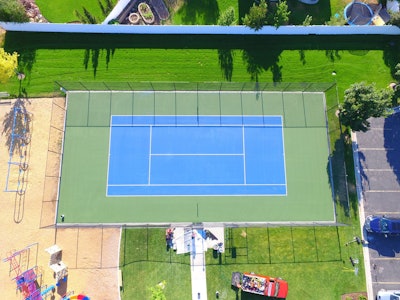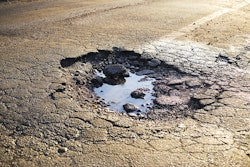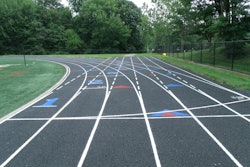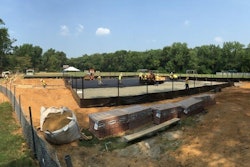
Sports courts can be the centerpiece of a town, neighborhood or park where sport enthusiasts flock to shoot some hoops or smash a few tennis balls over the net. The court and surface is extremely important to the game and the safety of the players. Depending on the sport, each court has its own unique challenges, specifications and client needs associated with it. Because of the unique nature of these projects, a more detailed approach to their design is needed to support athletic activities on this pavement.
Mix Designs
"The important part of each design, especially in regards to athletic asphalt, is to make sure we have the best ingredients possible and the best quality control to ensure the asphalt performs as desired," said Tim Murphy, president and owner of Murphy Pavement Technology, Inc.
When constructing a court for athletic use, it is imperative to use the correct Hot Mix Asphalt (HMA) one with a low-volume, fine-graded, virgin material mix design especially in the surface lift. The athletic use asphalt consists of a mixture of dense graded aggregate and specified type and grade of asphalt binder.  This is an example of stone cracking due to inadequate lift thickness in asphalt mix design.
This is an example of stone cracking due to inadequate lift thickness in asphalt mix design.
Proper lift thickness to build the asphalt is a crucial part, and when done correctly, this can mitigate challenges that might arise. The maximum aggregate size should be 1/2-in and yield a minimum 1 1/2-in lift thickness. Too course of a mix or too large of a maximum aggregate size will cause that stone to work up through the coating or cause breaking. Along with that, choosing a finer gradation will help drive down problems such a permeability into the mat.
"Depending on the mixture you design and specify, it might be easier or harder to get the density that is required to have the asphalt perform under its application," said Murphy. "For athletic asphalt, we are going to benefit from finer graded mix with slightly more oil."
For athletic courts specifically, there isn't further densification that happens, unlike roadways or parking lots. Consequently, targeting higher inplace density, no more than 6% air voids, will be beneficial. Increasing the inplace density, improving gradation or fine graded, reduction of maximum particle sizes and increase the asphalt content are all contributing factors to aid the longevity on lower volume surface applications.
"Utilizing the correct asphalt mix design, requiring proper production practices, performing process control and ensuring acceptable installation will lead to complaint asphalt that will not cause athletic coatings or surface to fail prematurely," said Murphy.
Selecting the best mix design according to the American Sports Builders Association (ASBA) guidelines, utilize softer asphalt, low air voids and quality control will help you successfully complete a complex sports court application. Athletic asphalt doesn't get the additional compaction that roadways or parking lots receive, increasing the density in the mat as well as the joints will help set you up for success.
Crack Mitigation
If proper density levels are not met, cracking will occur. Once the crack starts, moisture goes in and gets trapped with nowhere to Low density can cause these types of hairline cracks to the mat. If it isn't fixed, these cracks will show through the surface coating causing court failure.
Low density can cause these types of hairline cracks to the mat. If it isn't fixed, these cracks will show through the surface coating causing court failure.
Since there isn't additional compaction happening on these courts, a vibratory roller is necessary to achieve maximum compaction. According to the ASBA Asphalt Guidelines 'at least one vibratory roller shall be required for each project'. Most failures happen because of a lack of compaction to the asphalt lift.
Hard asphalt, high dust, low in-place density, variable volumetrics are some causes of premature cracking that usually start in the mat under the surface coating. To mitigate these risks, ensure your crew is taking into consideration proper quality control measures. Understanding the mix design is equally important and should be conveyed to the asphalt plant manager, straying away from Recycled Asphalt Pavements (RAP), iron pyrite and steel slag in surface lifts.
Another way to mitigate cracking before it happens is to make sure the base materials and surface list are adequate depth. The ASSBA recommends that an asphalt tennis court is 4-in plus of compacted base material and 1 1/2-in of asphalt lift, followed by a acrylic color surface coating system. In freeze and thaw climates, the compacted base should be 6-in plus and the asphalt lift should be 3-in plus before applying the color surface coating system.
Proper application, thickness, surface treatment and supporting materials will maximize the useful lifespan of these materials supporting the court.
"We can't have any failures, because anything happening below is just as expensive as the surface coating," Murphy concluded.











![Lee Boy Facility 2025 17 Use[16]](https://img.forconstructionpros.com/mindful/acbm/workspaces/default/uploads/2025/09/leeboy-facility-2025-17-use16.AbONDzEzbV.jpg?ar=16%3A9&auto=format%2Ccompress&fit=crop&h=135&q=70&w=240)








